Mastering the art of Washoku, Japan’s traditional cuisine, requires a deep understanding of its core techniques. From meticulously preparing rice to crafting the perfect dashi stock, these fundamental skills form the foundation for authentic Japanese cooking. By honing one’s abilities in these areas, home cooks and aspiring chefs alike can unlock the true essence of this revered culinary tradition. But the journey doesn’t end there – exploring cutting techniques and mastering the balance of flavors are equally vital steps on the path to Washoku mastery.
Key Points
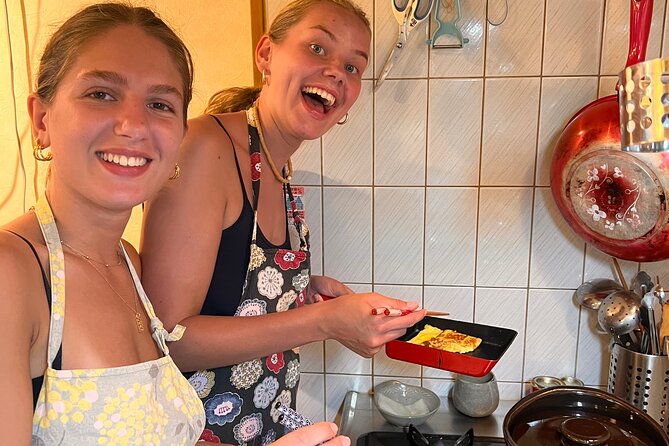
- Emphasize simplicity, balance, and the natural flavors of high-quality ingredients in Washoku cuisine.
- Master the art of preparing short-grain Japanese rice, from rinsing to precise steaming.
- Develop expertise in making dashi stock, the flavorful foundation of Washoku dishes.
- Utilize precise cutting and slicing techniques to enhance the visual appeal and texture of ingredients.
- Skillfully balance the five key seasonings – salty, sweet, sour, and umami – to create authentic Washoku flavors.
Fundamentals of Washoku Cuisine
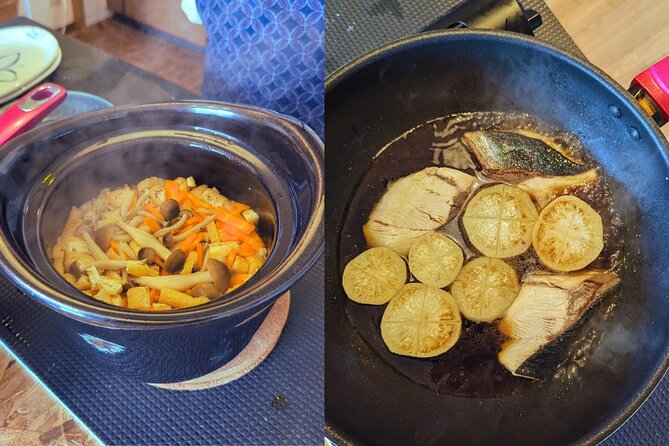
Although Washoku, the traditional cuisine of Japan, may seem intimidating to the uninitiated, its fundamentals are rooted in simplicity and balance.
The core techniques focus on harnessing the natural flavors of high-quality ingredients through gentle cooking methods. Umami, the savory fifth taste, is celebrated through the use of fermented sauces and seasonings.
Presentations emphasize seasonality and aesthetics, with dishes often arranged to evoke natural landscapes. Washoku’s holistic approach nurtures the senses, nourishing both body and spirit.
Want to bring Osaka Prefecture's flavors home? More hands-on cooking experiences we cover
Mastering the Art of Rice Preparation
At the heart of Washoku lies the mastery of rice preparation. Properly cooked rice is the foundation for many Japanese dishes.
The art of rice preparation involves:
- Selecting the right type of short-grain Japanese rice
- Rinsing the rice to remove excess starch
- Allowing the rice to soak for the optimal time
- Steaming the rice with precision
- Serving the rice at the perfect temperature and texture
Mastering these techniques ensures the rice imparts the ideal flavor, aroma, and mouthfeel to elevate the entire Washoku experience.
Perfecting the Dashi Stock
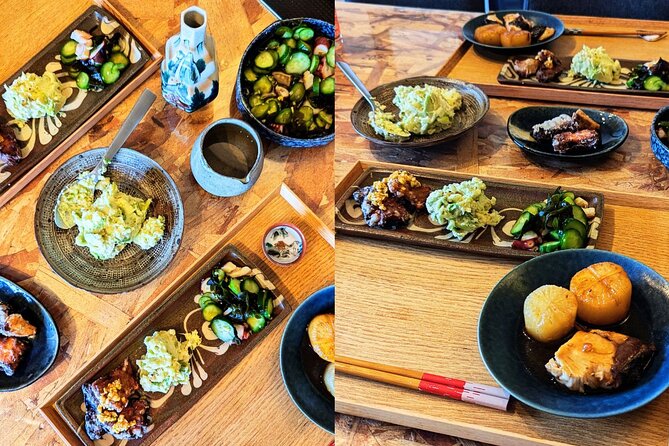
Dashi, the savory broth that forms the foundation of many Japanese dishes, is a defining element of Washoku cuisine.
Crafting the perfect dashi requires mastering the delicate balance of ingredients and techniques. The key is to use high-quality kombu (kelp) and katsuobushi (dried bonito flakes) in the right proportions, controlling the temperature and steeping time.
Patience is crucial, as rushing the process can result in a harsh, bitter flavor. The dashi must simmer gently, extracting the umami essence without overcooking.
Mastering this foundational element unlocks the true flavors of authentic Washoku cooking.
Techniques for Cutting and Slicing
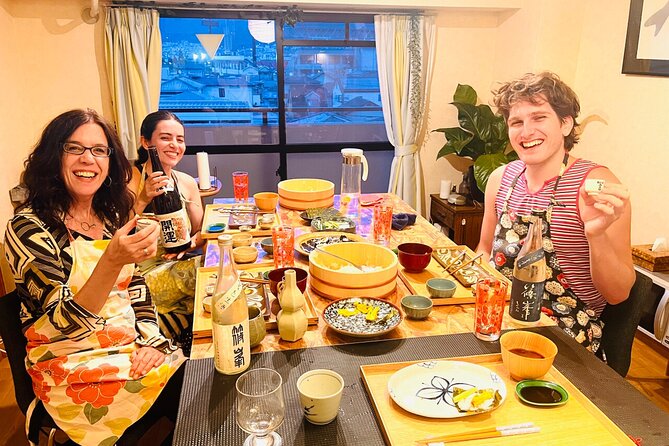
Beyond the foundational dashi, the art of Washoku encompasses a range of essential cutting and slicing techniques. Mastering these skills is crucial for achieving the signature textures and flavor profiles of traditional Japanese cuisine.
Key techniques include:
- Katsuramuki: Peeling vegetables into long, thin strips using a sharp knife
- Rangiri: Dicing ingredients into uniform, small cubes
- Sensuji: Slicing ingredients into delicate, paper-thin pieces
- Sashikiri: Cutting ingredients at a bias for visual appeal and unique mouthfeel
- Mehari-giri: Chopping ingredients into irregular, ragged pieces for robust texture
Precision and attention to detail are paramount in Washoku, as these techniques lay the foundation for the dish’s harmony and balance.
The Importance of Seasoning and Flavoring
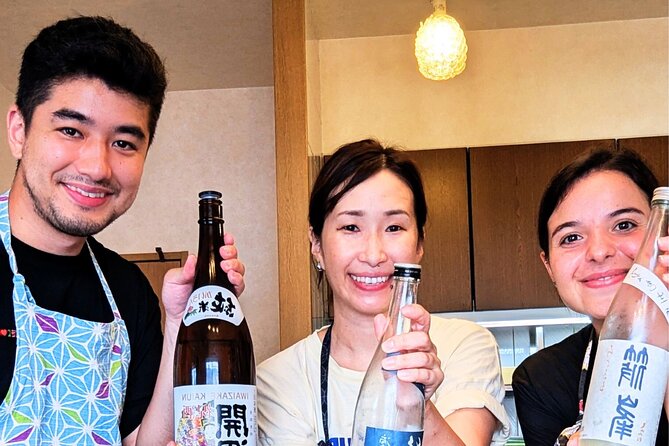
While the mastery of cutting and slicing techniques is essential, the true artistry of Washoku lies in the nuanced balance of seasoning and flavoring. Skillful chefs meticulously select and combine a variety of seasonings to elevate each dish’s umami profile. The following table outlines four key seasoning principles to elevate your Washoku cooking:
| Principle | Description |
|---|---|
| Salty | Enhance savory notes with soy sauce, salt, or miso. |
| Sweet | Incorporate sugar, mirin, or fruit to balance acidity. |
| Sour | Use citrus, vinegar, or pickled ingredients for brightness. |
| Umami | Deepen flavor with dashi, mushrooms, or aged ingredients. |
Mastering the art of seasoning is integral to crafting authentic Washoku dishes that captivate the senses.
- Shared Arrival Transfer: Osaka Itami Airport to Osaka City
- Private Kyoto Tour With Hotel Pickup and Drop off From Osaka
- Sushi Cooking Class by Matcha Experience Osaka
- Private Arrival Transfer From Osaka Itami International Airport to Kyoto City
- Cook Homestyle Ramen and Gyoza From Scratch
- Private Arrival Transfer From Kansai Airport to Osaka City
Plating and Presentation in Washoku
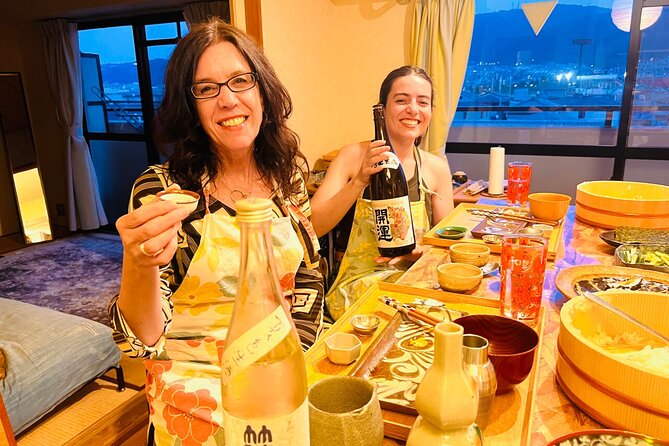
Along With mastering the fundamental techniques, the artful presentation of Washoku dishes is equally vital to the dining experience.
Washoku chefs meticulously arrange each element on the plate, considering balance, texture, and color harmony. This thoughtful plating elevates the senses and heightens the overall enjoyment.
Key elements of Washoku presentation include:
- Asymmetrical composition to create visual interest
- Selective use of garnishes, such as delicate herbs or edible flowers
- Placement of ingredients to showcase their natural beauty
- Thoughtful use of dinnerware to complement the dish
- Attention to portion size and spacing for a clean, uncluttered look
Incorporating Seasonal Ingredients
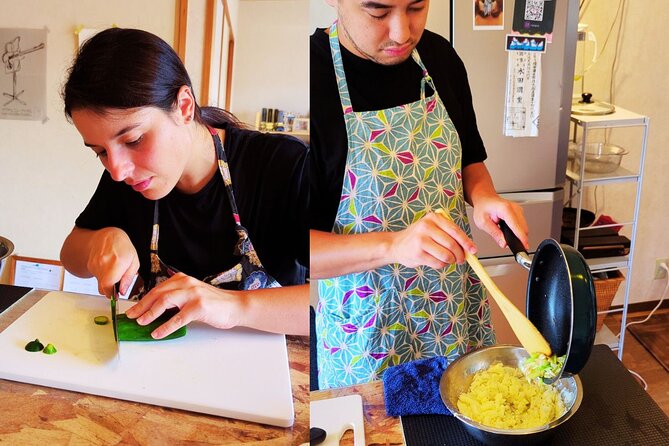
Seasonality is a key principle in Washoku, as chefs carefully select ingredients at the peak of their freshness and flavor. Honoring the natural cycles of produce, Washoku masters incorporate seasonal foods to create harmonious and nourishing dishes. This reverence for nature’s bounty is exemplified in the thoughtful selection of ingredients.
| Season | Ingredients | Preparation |
|---|---|---|
| Spring | Bamboo shoots, peas, sakura | Gentle steaming, light seasoning |
| Summer | Tomatoes, eggplant, corn | Grilling, quick pickling |
| Autumn | Matsutake mushrooms, sweet potatoes, chestnuts | Simmering, roasting |
| Winter | Daikon, mikan oranges, cod | Simmering, deep-frying |
The interplay of seasonal flavors and textures is the hallmark of Washoku, elevating the dining experience to an art form.
Developing an Eye for Aesthetics
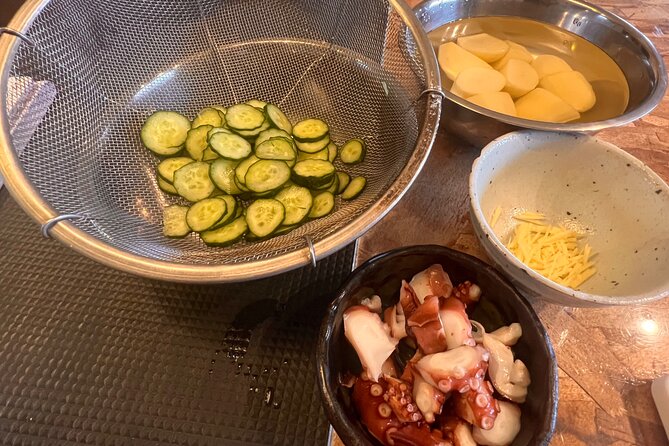
How does the meticulous attention to aesthetics elevate the Washoku experience? The visual presentation of each dish is paramount in Washoku. A trained eye for aesthetics ensures the harmonious arrangement of ingredients, the thoughtful placement of garnishes, and the overall balance of colors, textures, and shapes.
This artful approach engages the senses, heightening the dining experience:
- Precise placement of each element to create visual appeal
- Careful selection of plates, bowls, and utensils to complement the dish
- Judicious use of garnishes that add both flavor and visual interest
- Intentional use of colors, textures, and shapes to achieve visual harmony
- Attention to portion size and negative space for a refined, minimalist aesthetic
Frequently Asked Questions
Can I Request a Vegetarian or Vegan Menu Option?
The cooking class doesn’t specifically mention vegetarian or vegan options, but you can likely request these dietary accommodations when booking. It’s best to inquire about the menu choices available to ensure your dietary needs are met.
How Much Prior Cooking Experience Is Required for This Class?
The class is suitable for all skill levels, from beginners to experienced cooks. No prior cooking experience is required, as the instructor will teach the 5 core techniques of authentic washoku cooking from the ground up.
Is the Sake Included in the Price or an Additional Cost?
The sake is an optional addition, not included in the base price. Travelers can choose to add 3 types of sake for an extra cost of 45ml each.
Can I Book This Experience for a Larger Group?
The experience can accommodate up to 4 travelers per tour/activity. Larger groups may be possible, but travelers should check with the provider to confirm availability and any additional costs.
Is There a Minimum Age Requirement to Participate?
There’s no minimum age requirement for this experience. However, it’s not recommended for young children due to the complexity of the cooking techniques and the availability of alcoholic beverages during the meal.
The Sum Up
Mastering the five core techniques of Washoku – rice preparation, dashi stock, cutting techniques, seasoning, and plating – is essential for creating authentic Japanese cuisine. By understanding and executing these fundamental elements, home cooks can unlock the depth of flavor and aesthetic beauty that defines the Washoku culinary tradition. Embracing this holistic approach is the key to achieving true Washoku mastery.
More Cooking Classes in Osaka Prefecture
More Tour Reviews in Osaka Prefecture
- Kobe Delights: Arima Onsen, Sake Breweries & Kobe Beef VIP Tour
- Ukiyoe Art on Glass Labels for Japanese Sake
- Ramen and Gyoza Cooking Class in Osakas Nukatach
- Taiko Japanese Drum Experience in Osaka
- Osaka Kansai Airport (KIX) to Osaka Hotels – Arrival Private Transfer
- 10 Hours Private City Tour in Osaka – Chartered Tour
Not for you? Here's more things to do in Osaka Prefecture we have recnetly reviewed
- 6 Best Cruises And Boat Tours In Osaka Prefecture
- Kyoto Private Tour (Shore Excursion Available From Osaka or Kobe Port)
- Osaka Private Tour With English-Speaking Driver
- Private Takoyaki Cooking Class by Natives in Osaka
- Private Full-Day Japanese Mountain Guided Tour: Ikoma
- Osaka River Rapids Hike and Natural Hot Spring Tour
- Airport Transfer! Osaka Airport (ITM) to Center of Hotel in Osaka
- Kyoto Private Tour With Pick and Drop
- From Osaka/Kyoto: Hiroshima Miyajima Luxury Tour With Guide
- 1 Day JR Pass to West Kansai Area
- Japans Indigo Dyeing Experience – Bring Your Own Cloth to Dye
- Private Osaka to Sea of Kyoto Tour
